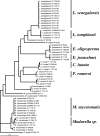Molecular identification of black-grain mycetoma agents
- PMID: 17021076
- PMCID: PMC1594755
- DOI: 10.1128/JCM.00862-06
Molecular identification of black-grain mycetoma agents
Abstract
Black-grain mycetomas are subcutaneous devastating chronic infections due to several dematiaceous fungi. They are diagnosed mostly in tropical countries. Identification of these fungi with standard mycological procedures is difficult because of their poor or delayed sporulation. The aim of this study was thus to assess the accuracy of molecular identification of these fungi. A total of 54 strains, mostly of clinical origin, were used, including 15 Madurella mycetomatis, 6 Madurella grisea, 12 Leptosphaeria senegalensis, 4 Leptosphaeria tompkinsii, 6 Pyrenochaeta spp., 4 Curvularia lunata, and 7 Exophiala jeanselmei strains. The internal transcribed spacer 1 (ITS1)-5.8S-ITS2 DNA region was amplified by using universal fungal primers and sequenced. Both intra- and interspecies sequence similarities were assessed. Madurella mycetomatis appeared to be a homogeneous species. More intraspecies variations were found for C. lunata and E. jeanselmei, leading, in some instances, to changes in the initial identification. L. senegalensis and L. tompkinsii showed intraspecies similarities of >99%, but similarity between the two species was <88%. Intergenera and interspecies variations were important, with sequence homologies of <81% between genera. In contrast, Pyrenochaeta romeroi and M. grisea appeared to be heterogeneous, with intraspecies similarities of 40 to 100% and 53 to 100%, respectively, which suggest either erroneous identification or the need for taxonomic revision. Epidemiological and therapeutic studies could benefit from a precise identification of the fungi responsible for black-grain mycetoma based not only on phenotypical characteristics but also on ITS sequencing.
Figures



References
-
- Ahmed, A. O., M. M. Mukhtar, M. Kools-Sijmons, A. H. Fahal, S. de Hoog, B. G. van den Ende, E. E. Zijlstra, H. Verbrugh, E. S. Abugroun, A. M. Elhassan, and A. van Belkum. 1999. Development of a species-specific PCR-restriction fragment length polymorphism analysis procedure for identification of Madurella mycetomatis. J. Clin. Microbiol. 37:3175-3178. - PMC - PubMed
-
- Ahmed, A. O., W. van Leeuwen, A. Fahal, W. van de Sande, H. Verbrugh, and A. van Belkum. 2004. Mycetoma caused by Madurella mycetomatis: a neglected infectious burden. Lancet Infect. Dis. 4:566-574. - PubMed
-
- de Hoog, G. S., D. Adelmann, A. O. Ahmed, and A. van Belkum. 2004. Phylogeny and typification of Madurella mycetomatis, with a comparison of other agents of eumycetoma. Mycoses 47:121-130. - PubMed
MeSH terms
Substances
LinkOut - more resources
Full Text Sources
Miscellaneous

